SQLCipher for Windows System.Data.SQLite
Commercial & Enterprise Edition Feature
SQLCipher for Windows System.Data.SQLite provides full database SQLite encryption for .NET 4 based applications on x86 / x64 (non-ARM) platforms that are distributed outside of the Windows Store. This ADO.NET provider, based on System.Data.SQLite, makes it quick and easy to integrate SQLCipher's AES-256 full database encryption into an application. It is fully interoperable with other SQLCipher platform libraries. It supports .NET Framework 4.6 or higher. Older versions of the .NET framework are not supported.
The SQLCipher for Windows System.Data.SQLite provider is a Commercial Edition library that can be purchased directly from the Zetetic Store. Licensed software is delivered immediately upon payment.
Buy SQLCipher for Windows System.Data.SQLite Now »
Folder Structure and Native Preloading
The library uses an approach called native preloading to separate platform specific interop assemblies for each supported architecture into individual folders. This allows managed code to load the correct interop library based on the platform the application is running within (i.e. x86 or x64).
This approach allows an application to be built for "Any CPU". Then, the application using SQLCipher is packaged or installed along with the native interop assemblies. When the application is executed the .NET runtime will detect the current platform architecture, look for a matching named folder under the root of the application folder, and then load the appropriate interop library found there. This allows SQLCipher's managed-only assembly to reference native code in a cross-platform way.
Native Preloading requires a specific folder setup, as follows, which is described in this tutorial:
\App.exe (optional, managed-only application executable assembly) \App.dll (optional, managed-only application library assembly) \System.Data.SQLite.dll (required, managed-only core assembly) \System.Data.SQLite.Linq.dll (optional, managed-only LINQ assembly) \System.Data.SQLite.EF6.dll (optional, managed-only EF6 assembly) \x86\SQLite.Interop.dll (required, x86 native interop assembly) \x64\SQLite.Interop.dll (required, x64 native interop assembly)
Within this structure the application executables and supporting library assemblies (e.g. System.Data.SQLite.* from the SQLCipher package) exist at the top level of the application folder. The x86 and x64 subfolders exist under the top level and contain the native interop assemblies.
Integration Tutorial
The remainder of this document provides a practical example of how to integrate SQLCipher for Windows System.Data.SQLite. This tutorial assumes the use of Visual Studio 2013 on a local development machine, with SQLCipher being added to an existing project.
Unzip Package
Start by unzipping the SQLCipher binary package, sqlcipher-ado.
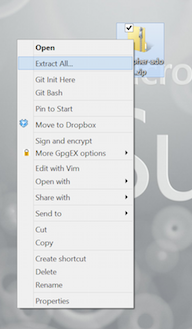
Next, move the expanded resources somewhere into the project folder structure.

Add References
Open the project in Visual Studio. Right click on References in the Solution Explorer, and select "Add References".
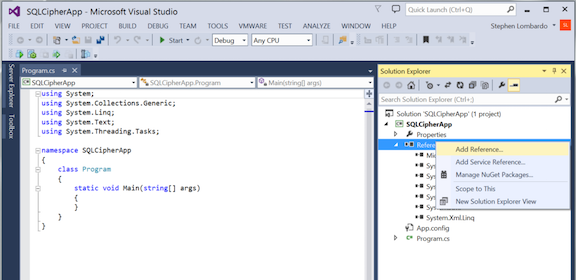
Switch to the "Browse" mode, and then locate the folder containing the binary packages and add System.Data.SQlite.dll and System.Data.SQLite.Linq.dll to the project:
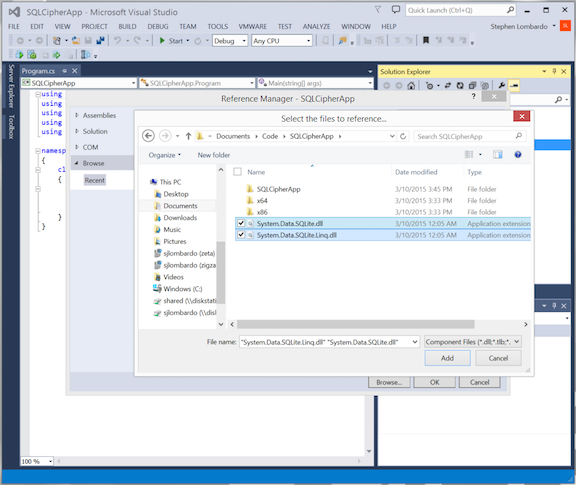
Add Interop Libraries
Right click on the project root in the Solution Explorer, and select "Add, New Folder".
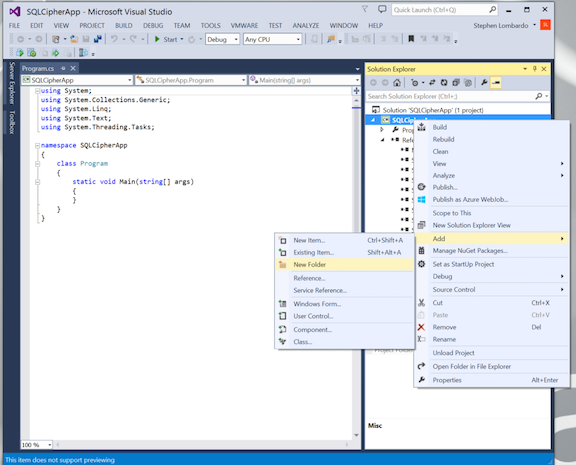
Create two folders at the top level, one named x86 and one named x64
Right click on the new x86 folder, and choose "Add, Existing Item". Browse to locate the SQLite.Interop.dll file from the corresponding x86 folder of the SQLCipher package.
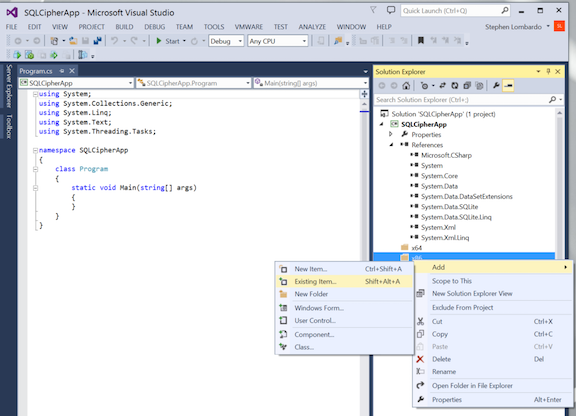
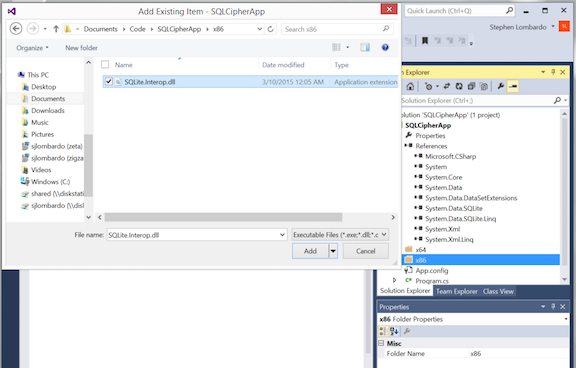
Select the x86 SQLite.Interop.dll files in Solution Explorer, and change the "Copy to Output Directory" Property to "Copy always"
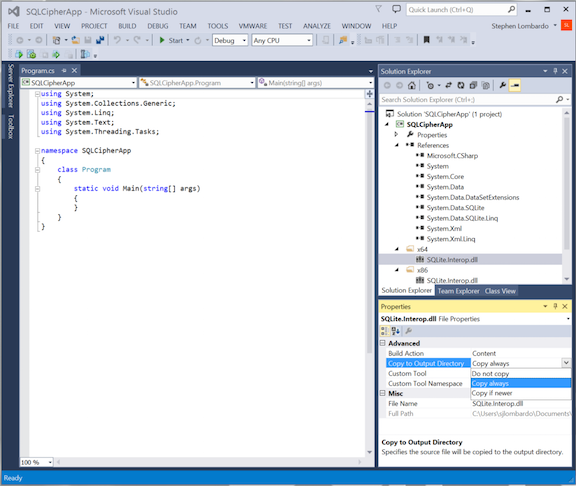
Repeat the same process to create the x64 folder, add the corresponding x64 SQLite.Interop.dll file, and set itto "Copy Always".
Use SQLCipher
Next, add "using System.Data.SQLite;" to the program source code to begin using the library.
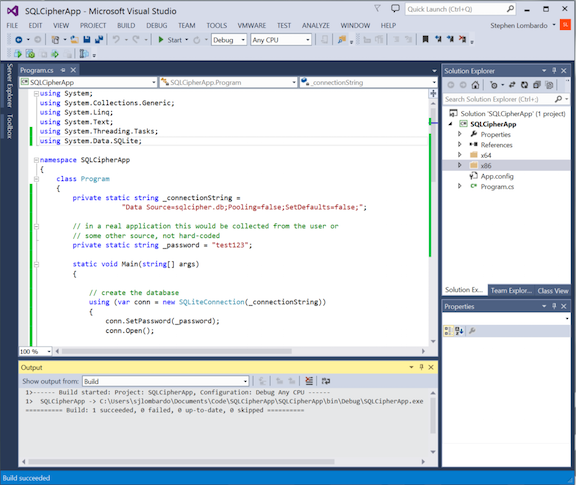
When the application is compiled the final build output will include the x86 and x64 folders. Make sure these resources are installed along with the application.
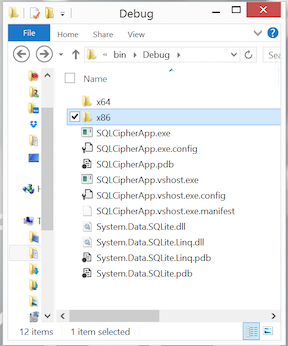
Code Example
The following simplified example code demonstrates how to create and query an encrypted SQLCipher database.
using System;
using System.Collections.Generic;
using System.Linq;
using System.Text;
using System.Threading.Tasks;
using System.Data.SQLite;
namespace SQLCipherApp
{
class Program
{
private static string _connectionString =
"Data Source=sqlcipher.db;Pooling=false;SetDefaults=false;";
// in a real application this would be collected from the user or
// some other source, not hard-coded
private static string _password = "test123";
static void Main(string[] args)
{
// create the database
using (var conn = new SQLiteConnection(_connectionString))
{
conn.SetPassword(_password);
conn.Open();
using (var cmd = conn.CreateCommand())
{
// When using Commercial or Enterprise packages you must call PRAGMA cipher_license with a valid License Code.
// Failure to provide a license code will result in an SQLITE_AUTH(23) error.
// Trial licenses are available at https://www.zetetic.net/sqlcipher/trial/
cmd.CommandText = "PRAGMA cipher_license='YOUR LICENSE CODE HERE';";
cmd.ExecuteNonQuery();
cmd.CommandText = "CREATE TABLE IF NOT EXISTS t1(a,b);";
cmd.ExecuteNonQuery();
cmd.CommandText = "INSERT INTO t1(a,b) VALUES ('test0', 'test1');";
cmd.ExecuteNonQuery();
}
conn.Close();
}
using (var conn = new SQLiteConnection(_connectionString))
{
conn.SetPassword(_password);
conn.Open();
using (var cmd = conn.CreateCommand())
{
cmd.CommandText = "SELECT * FROM t1;";
var reader = cmd.ExecuteReader();
while (reader.Read())
{
System.Console.WriteLine(string.Format("{0} | {1}", reader.GetString(0), reader.GetString(1)));
}
}
}
}
}
}
Using System.Data.Common with SQLCipher
It's also possible to use the System.Data.Common ADO.NET interfaces with SQLCipher. Using this API, the SQLCipher provider is loaded via the DbProviderFactory interfaces:
using System.Data.Common;
using System.Data.SQLite;
...
DbProviderFactory provider = DbProviderFactories.GetFactory("System.Data.SQLite");
using (DbConnection conn = provider.CreateConnection())
{
conn.ConnectionString = "Data Source=sqlcipher.db;Pooling=false;Synchronous=Full;";
((SQLiteConnection)conn).SetPassword("secret");
conn.Open();
using (IDbCommand command = conn.CreateCommand())
{
command.CommandText = "CREATE TABLE t1(a,b);";
command.ExecuteNonQuery();
}
...
}
When using System.Data.Common the following App.config changes are required so that the provider can be loaded at runtime (note that the Version for the provider changes from release to release, and is found in the package README.
<configuration>
<system.data>
<DbProviderFactories>
<remove invariant="System.Data.SQLite"/>
<add name="SQLite Data Provider" invariant="System.Data.SQLite"
description=".Net Framework Data Provider for SQLite" type="System.Data.SQLite.SQLiteFactory, System.Data.SQLite, Version=1.0.XX.0, Culture=neutral, PublicKeyToken=2afdc9349188e576" />
</DbProviderFactories>
</system.data>
</configuration>
Get SQLCipher for Windows System.Data.SQLite
Purchase directly from the Zetetic Store. Licensed software is delivered immediately upon payment.